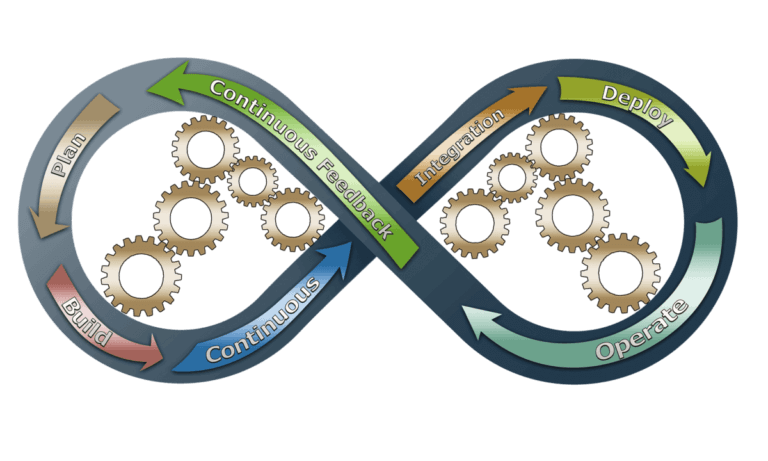
Continuous testing is end-to-end automated testing that is an integral part of DevOps and is conducted at every level of development in various forms. It acts as a catalyst in speeding up the CI/CD pipeline, by incorporating automated processes and tools for testing early and testing often at all points of time.
Organizations need to follow certain best practices and have a sound strategy in place, in order to reap maximum benefits by implementing Continuous testing in their DevOps process.
This article discusses the top 5 best practices that can be adopted for a comprehensive continuous testing process.
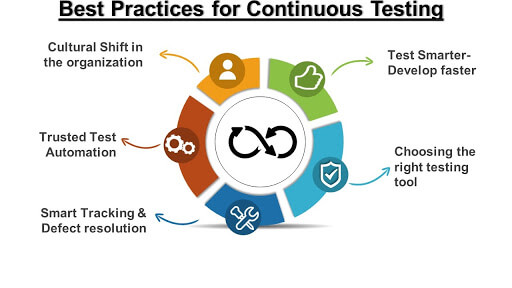
The above figure enunciates the best practices involved in implementing Continuous testing in your CI/CD pipeline. Let us discuss these practices further in detail.
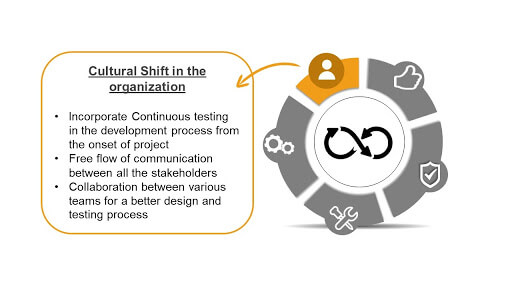
Continuous testing is not just a “technical process”. It is a mindset too. Just having a technical process in place is futile, unless relevant stakeholders are willing to embrace it. For that to happen, a free flow of communication and collaboration is required between the software architects, developers, and QA team. They should be involved from the very onset of the project to understand the intricacies of client requirements and work upon them accordingly.
Continuous testing implies “test early-test often”. In order to implement this, a holistic testing strategy is needed, which can be devised when there is a meaningful collaboration and information exchange is done more frequently so that all the stakeholders are on the same page. Everyone involved in design-development-testing has to be kept updated on user stories and any changes are immediately communicated to them.
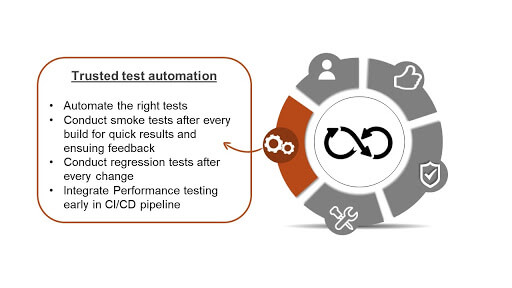
Continuous testing involves frequent testing, hence it is a good idea to automate the business-critical test cases in order to accelerate the end-to-end testing. This not only speeds up the whole testing-feedback loop but significantly improves the quality of the build, leading to the overall health improvement of the software. However, choosing the right cases to automate is the key to successful automation. Read more about it on our blog about test case prioritization.
Test automation responsibility must be shouldered jointly by the development and testing team, in order to achieve a holistic approach towards automation. This approach not only expedites the whole development process but also helps in improving feature velocity and aids in achieving shorter delivery cycles.
It is imperative to run smoke tests and regression tests after every build to ensure that new feature inclusions, modifications, or bug fixing have not inadvertently broken any critical business scenarios, and the build is working as per the expectations.
Shift left approach towards performance testing is gaining importance these days. Conducting performance tests early in development cycles also ensures that besides the functionality, the performance criteria have been met too, thus confirming the reliability and robustness of the application under test.
A very important factor to consider is that the automation test results should be dependable. Many times there are false failures, which sends the development and QA team on a wild goose chase, leading to wastage of time and efforts. Incidents like these pose question marks on the automated results.
Webomates has an ingenious AI-based Defect predictor which handles such situations. Click here to learn more about our Defect Predictor.
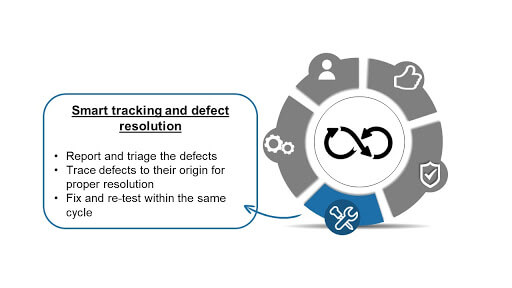
Identifying defects is just one milestone achieved. Triaging, reporting, and sharing the defect details across the board is extremely important to keep the ball rolling for a CI/CD/CT process.
Defect triage is an important part of testing because it ensures that the team focuses on the right defect on the basis of:
Ideally, reported defects should have evidence to support, like videos or screenshots, or logs. This information helps in a better understanding, leading to quick resolutions.
Read more about it on our blog about defect triaging.
Once identified and marked for resolution, it is important to trace its origin to correct the root cause which led to the defect. It could have happened at any point of time during the whole design-development-testing phase.
Having identified the origin of the defect, the teams should work together to fix and re-test it. At the same time, it is essential to keep an eye on the bug curve. If the number of defects is reducing with every testing cycle, it means that the testing strategy is on the right track. However, if the curve hits a plateau or follows an upward trend, then it is time to re-strategize.
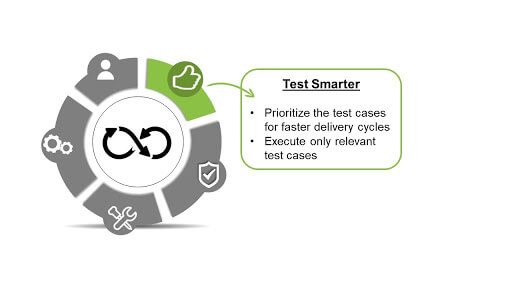
Test smart, develop fast, test continuously is the thumb rule for a successful sprint. Continuous testing means that the same tests may be conducted multiple times within the same cycle. Executing all the tests will slow down the whole process, and testing may end up becoming the bottleneck of the CI/CD/CT pipeline. Hence, prioritizing the test cases and preparing mini test suites to be executed at every build check-in is the right way forward. These test mini-suites can be made by selecting the test cases on the basis of importance, risk factor, time is taken for execution.
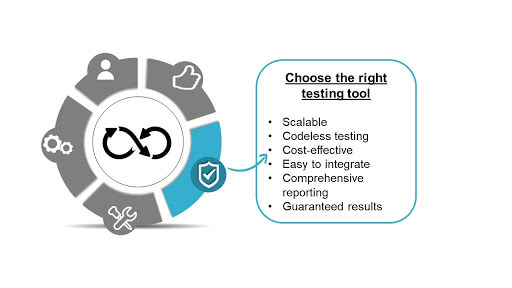
What is the point of having best practices fundamentals in place, but no testing tool at your disposal to implement those? Let us take a look at the list of criteria that may help you in making the right choice.
Scalability: There should be a provision of scaling up and down of functional testing as per the need. It should also have the flexibility to address the time constraints and conduct testing within a specified time frame.
Codeless testing: The tester should be able to effortlessly generate test cases without writing extra lines of code. It is all about empowering the developers and testers by saving their time and efforts. It aids in channelizing the efforts in the right direction and gives them the bandwidth to focus on the right job.
Cost-effective: There should be a provision for multiple payment options for ROI-conscious organizations based on the number of test cases executed.
Integration within CI/CD pipeline: A perfect tool should be able to seamlessly integrate within the existing CI/CD pipeline. It should be able to provide a stable testing environment with multiple test suites, which can execute at different points of time as per the need.
Comprehensive reporting: Reporting is an important aspect of the whole testing process. The involved teams have to be alerted about defects in real-time, so that the turnaround time for defect triaging, analyzing, fixing, and re-testing is reduced.
Additionally, if a testing tool comes with test guarantees, then it definitely is an added bonus.

Webomates CQ checks all the above-mentioned criteria and helps the organizations in bridging the gap between the dream and reality of continuous testing.
It is a cost-effective tool that seamlessly integrates with your CI/CD pipeline within a matter of hours.
Our tool leverages the power of AI/ML for the codeless generation of test cases. Functional test cases can be converted to performance test cases just by a click.
QA teams can use Webomates CQ to carry out testing by using mini test suites during development in conjunction with the developers. Defects are triaged and detailed feedback is provided to the developers and other stakeholders via real-time alerts.
Webomates applies AI and ML algorithms to its self-healing test automation framework in order to dynamically adapt the testing scope to any changes. Healed test suites lead to faster testing and development, thus speeding up the entire release process.
Besides modifying and executing the affected test cases, there is a service level guarantee that all possible test scenarios have been covered.
At Webomates, we continuously work to evolve our platform and processes, in order to provide guaranteed execution, which takes testing experience to an entirely different level, thus ensuring a higher degree of customer satisfaction.
If this has piqued your interest and you want to know more, then please click here and schedule a demo, or reach out to us at info@webomates.com. If you liked this blog, then please like/follow us Webomates or Aseem.
Tags: Automation Testing, CI/CD, continuous testing, Shift left
Test Smarter, Not Harder: Get Your Free Trial Today!
Start Free Trial
Leave a Reply